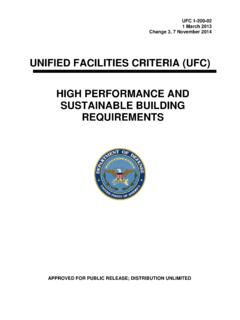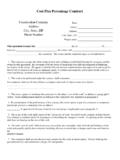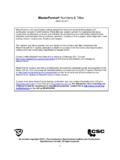Transcription of Introduction to Contract Pricing
1 Chapter: Intro - 1 - 2 - 3 - 4 - 5 - 6 - 7 -8 - 9 -10 Introduction to Contract Pricing - Chapter Introduction - Identifying The Seller's Pricing Objectives And Approaches o - Identify Seller's Pricing Objectives o - Identify Seller's Approaches To Pricing o - Review Seller's Cost-Based Pricing Strategies o - Review Seller's Market-Based Pricing Strategies - Identifying Government's Pricing Objective o - Pay A Fair And Reasonable Price o - Price Each Contract Separately o - Exclude Contingencies - Identifying Government Approaches to Contract Pricing o - Identify Price Analysis Considerations o - Identify Cost Analysis Considerations o - Identify Cost Realism Analysis Considerations - Identifying Potential Acquisition Team Members Chapter 1 - Conducting Market research for Price Analysis - Chapter Introduction - Reviewing The Purchase Request And Related Market Research o - How Was The Estimate Made?
2 O - What Assumptions Were Made? o - What Information And Analysis Were Used? o - Where Was The Information Obtained? o - How Did Previous Estimates Compare With Prices Paid? - Considering Contract Pricing In Your Market Research o - Historical Pricing data For Market Research o - Published data For Market Research o - Market Research data From Buyers And Other Experts o - Market Research data From Prospective Offerors o - Market Research data From Other Sources - Using Market Research To Estimate Probable Price o - Evaluating Your Market Research o - Developing Your Price Estimate Chapter 2 - Maximizing Price Competition - Chapter Introduction - Improving the Schedule o.
3 Consolidate the Requirements o - Describe Government Needs to Promote Competition o - Review Requirements Documents o - Use and Maintain Requirements Documents o - Acquire Other Than New Material o - Consider Delivery or Performance Schedules o - Use Liquidated Damages o - Consider Variation in Quantity o - Pursue Restrictive Requirement Relief - Improving Business Terms and Conditions o - Base The Contract Type On Risk Analysis o - Review Applicability Of Socioeconomic Requirements o - Match Payment And Finance Terms to Market Conditions o - Furnish Government Property o - Consider Warranty Requirements o - Optimize Price/Technical Tradeoffs - Publicizing The Acquisition Chapter 3 - Price-Related data From Offerors - Chapter Introduction - Cost or Pricing data - Cost or Pricing data Exceptions o - Adequate Price Competition Exception o - Price Set by Law or regulation Exception o - Commercial Item Exception o - Waiver Exception - Information Other Than Cost or Pricing data Chapter 4 - Identifying Possible
4 Combinations For Award - Chapter Introduction - Aggregate Award Of All Line Items To One Contractor - Multiple Awards For Different Line Items - Family Or Group Buys - Progressive Awards For Portions Of Total Line Item Requirement - Multiple Awards For The Same Line Item - Split Awards - Partial Set-Aside Awards Chapter 5 - Identifying And Applying Price-Related Factors - Chapter Introduction - Assumed Administrative Cost Factors - Buy American Act Criteria o - FAR Criteria o - DFARS Criteria - Government Furnished Production And Research Property Factors o - Competitive Advantage o - - Consider Costs And Savings To The Government - Transportation Costs - Options And Multiyear Contracting o - Options o - Multi-Year Contracting - Life-Cycle Costs - Energy Conservation And Efficiency Factors - Lease Vs.
5 Purchase Factors - Small Disadvantaged Business Price Evaluation Adjustment - HUBZone Price Evaluation Preference Chapter 6 - Comparing Prices - Chapter Introduction - Selecting Prices For Comparison o - Other Proposed Prices o - Commercial Prices o - Previously-Proposed Prices And Contract Prices o - Parametric And Rough Yardsticks Estimates o - Independent Government Estimates - Identifying Factors That Affect Comparability - Determining The Effect Of Identified Factors - Adjusting The Prices Selected For Comparison - Comparing Adjusted Prices Chapter 7 - Accounting For Differences - Chapter Introduction - Identifying Vendor-Related Differences o - Responsibility o - Understanding Of Requirements o - Technology o - Efficiency o - Strategy o - Mistakes - Identifying Market-Related Differences o - General Market Conditions o - Contract Requirements Chapter 8 - Price-Related Decisions In Sealed Bidding - Chapter Introduction - Examine Individual Bids o - Suspected Mistakes In Bids o.
6 Unbalanced Bids - Determine Need To Cancel The IFB o - Price-Related Reasons For Canceling The IFB o - Negotiation After Cancellation Chapter 9 - Price-Related Decisions In Negotiations - Introduction - Determine The Need For Cost Information - Determine The Need For Discussions - Determine The Competitive Range - Determine The Need For Prenegotiation Exchanges - Establish Pre-Negotiation Price Positions o - Analyze Risk o - Develop Negotiation Positions - Consider Potential Trade-Offs Between Price And Other Terms - Determine The Need To Cancel And Resolicit Chapter 10 - Documenting Pricing Actions - Introduction - Documenting Actions In Sealed Bidding o - Record All Bids o - Record The Reason For Rejection Of Bids o - Record How Any Ties Were Broken o - Identify The Basis For Considering The Award Price Reasonable - Documenting Actions In Negotiations - Chapter Introduction - Identifying The Seller's Pricing Objectives And Approaches o - Identify Seller's Pricing Objectives o - Identify Seller's
7 Approaches To Pricing o - Review Seller's Cost-Based Pricing Strategies o - Review Seller's Market-Based Pricing Strategies - Identifying Government's Pricing Objective o - Pay A Fair And Reasonable Price o - Price Each Contract Separately o - Exclude Contingencies - Identifying Government Approaches to Contract Pricing o - Identify Price Analysis Considerations o - Identify Cost Analysis Considerations o - Identify Cost Realism Analysis Considerations - Identifying Potential Acquisition Team Members Chapter Introduction Contract Pricing Environment.
8 An important part of your job as a Contract specialist is to conduct the price analyses necessary to ensure that the Government purchases supplies and services from responsible sources at fair and reasonable prices. To begin your study of Contract Pricing , we will examine the Pricing environment, including: Definitions of price; Seller Pricing objectives and approaches; The Government Pricing objective; Government approaches to Contract Pricing ; and Potential participants in the acquisition process Definitions of Price. From both work and personal business dealings, most people think of price as the amount of money that a buyer pays a seller for the delivery of a product or the performance of a service.
9 The FAR definition of price (FAR ) emphasizes its components: Cost plus any fee or profit applicable to the Contract type. Both definitions of price are important. Primarily, price is defined as the amount the buyer pays for a product or service. However, it is important to remember that, if prices do not cover supplier costs and provide a profit, losses will occur. When a Contract is priced below cost, performance risk increases. The contractor must finance Contract performance with funds from other sources ( , profits from other contracts, financial reserves, or overpriced Contract modifications).
10 If contractor efforts to control costs result in unsatisfactory performance, contractor default is a real possibility. - Identifying The Seller's Pricing Objectives And Approaches This section covers the following topics: - Identify Seller's Pricing Objectives - Identify Seller's Approaches To Pricing - Review Seller's Cost-Based Pricing Strategies - Review Seller's Market-Based Strategies Pricing Perspectives. Buyers and sellers look at the same price from dif















